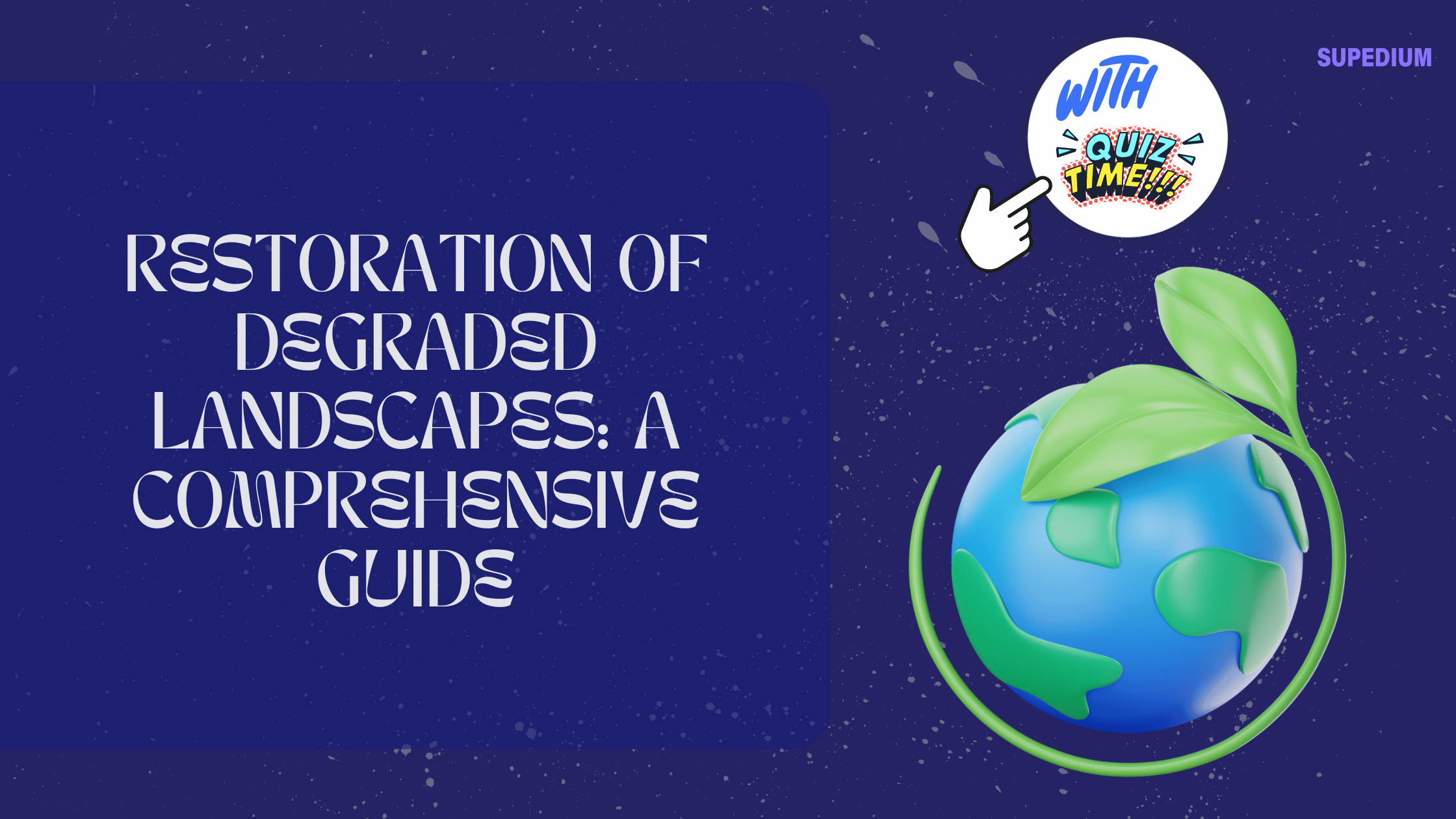Table of Contents
![]()
Introduction
Definition of Degraded Landscapes
Degraded landscapes are areas where the natural environment has been significantly impaired or altered, resulting in reduced ecological health and functionality. These landscapes often exhibit characteristics such as erosion, loss of biodiversity, and pollution. Common examples include deforested regions, abandoned mining sites, and polluted wetlands. Degradation can severely impact both the environment and human livelihoods, making restoration efforts essential.
Importance of Landscape Restoration
Restoring degraded landscapes is crucial for several reasons. Environmentally, restoration can lead to improved biodiversity, enhanced soil fertility, and better water quality. Socially and economically, it can revitalize local communities by creating job opportunities, boosting recreational areas, and improving overall quality of life. Moreover, effective restoration practices contribute to climate change mitigation and adaptation, helping to reduce greenhouse gas emissions and increase resilience to climate impacts.
Objectives of Restoration
The primary objectives of landscape restoration are to:
- Restore Ecosystem Functions: Rebuilding the natural processes that support ecological balance and resilience.
- Reestablish Native Species: Reintroducing indigenous flora and fauna to promote biodiversity.
- Enhance Ecosystem Services: Improving services such as water purification, pollination, and carbon sequestration.
Causes of Landscape Degradation
Natural Causes
Natural processes can contribute to landscape degradation, including:
- Erosion and Sedimentation: Natural erosion can lead to the loss of fertile topsoil and sedimentation in water bodies.
- Wildfires: While fire is a natural part of many ecosystems, uncontrolled wildfires can devastate large areas and lead to long-term degradation.
- Flooding and Droughts: Extreme weather events can disrupt ecosystems, leading to soil erosion, loss of vegetation, and changes in hydrology.
Human Activities
Human activities are significant drivers of landscape degradation:
- Deforestation and Land Clearing: Removing forests for agriculture or urban development results in habitat loss and increased erosion.
- Agriculture and Overgrazing: Intensive farming practices and overgrazing deplete soil nutrients and degrade land.
- Urbanization and Industrialization: Expanding cities and industrial activities lead to habitat destruction and pollution.
- Mining and Resource Extraction: Mining operations can cause extensive environmental damage, including soil erosion and contamination.
- Pollution: Air, water, and soil pollution from various sources can impair ecosystem health.
Assessment and Planning
Site Assessment
Effective restoration begins with a thorough site assessment:
- Identifying the Extent and Type of Degradation: Mapping the affected area and determining the degree of degradation.
- Analyzing Soil Health and Fertility: Assessing soil quality to understand nutrient deficiencies and contamination levels.
- Assessing Biodiversity and Ecosystem Health: Evaluating the presence and diversity of plant and animal species.
- Evaluating Hydrology and Water Resources: Understanding water availability and quality, including potential sources of contamination.
Setting Restoration Goals
Restoration goals should be clear and actionable:
- Defining Specific, Measurable Objectives: Establishing goals such as reforestation targets or water quality improvements.
- Prioritizing Actions: Focusing on areas with the greatest need or potential for impact.
- Involving Stakeholders and Local Communities: Ensuring that local voices are heard and integrated into the restoration process.
Developing a Restoration Plan
A comprehensive restoration plan includes:
- Choosing Appropriate Restoration Techniques: Selecting methods based on the specific needs of the site and goals.
- Establishing Timelines and Milestones: Creating a schedule for implementation and progress assessment.
- Budgeting and Resource Allocation: Estimating costs and securing necessary resources.
Restoration Techniques
Ecological Restoration
Various techniques are used in ecological restoration:
- Reforestation and Afforestation: Planting trees to restore forest ecosystems or create new forests in deforested areas.
- Wetland Restoration: Rehabilitating wetlands to improve water quality, support wildlife, and mitigate floods.
- Riparian Zone Restoration: Restoring vegetation along waterways to reduce erosion and enhance habitat.
- Grassland and Prairie Restoration: Reintroducing native grasses and plants to restore grassland ecosystems.
Soil and Water Conservation
Soil and water conservation methods are essential for successful restoration:
- Erosion Control Measures: Implementing techniques such as terracing and check dams to prevent soil loss.
- Soil Amendment and Fertility Improvement: Adding organic matter or nutrients to restore soil health.
- Water Management: Using rainwater harvesting, irrigation systems, and other practices to manage water resources effectively.
Rehabilitation and Reconstruction
Restoration may involve physical and ecological reconstruction:
- Reconstructing Physical Landscapes: Adjusting land contours and rebuilding natural features to support ecological recovery.
- Reintroducing Native Plant and Animal Species: Reestablishing species that are integral to the ecosystem.
- Building Infrastructure for Habitat Protection: Creating features such as fencing or signage to protect restored areas.
Community-Based and Participatory Approaches
Engaging local communities is vital for successful restoration:
- Engaging Local Communities: Involving residents in planning and implementation to ensure that restoration efforts meet local needs.
- Traditional Knowledge and Practices: Incorporating indigenous and local knowledge to enhance restoration strategies.
- Education and Awareness Programs: Raising awareness about the importance of restoration and encouraging community involvement.
Monitoring and Evaluation
Monitoring Progress
Ongoing monitoring helps track the success of restoration efforts:
- Tracking Ecological Indicators: Observing changes in plant growth, wildlife presence, and overall ecosystem health.
- Assessing Changes in Soil and Water Quality: Measuring improvements in soil fertility and water purity.
- Evaluating the Success of Implemented Techniques: Reviewing whether restoration methods are achieving their intended outcomes.
Adjusting Strategies
Adaptation is key to effective restoration:
- Identifying Challenges and Obstacles: Recognizing and addressing any issues that arise during the restoration process.
- Adapting Techniques Based on Feedback and Results: Modifying strategies as needed to improve effectiveness.
- Incorporating New Research and Technologies: Applying the latest scientific knowledge and innovations to enhance restoration efforts.
Reporting and Documentation
Transparent reporting and documentation are important:
- Documenting Methods and Outcomes: Keeping detailed records of restoration practices and results.
- Sharing Findings with Stakeholders and the Public: Communicating progress and results to all involved parties.
- Publishing Results in Scientific and Policy Forums: Contributing to the broader knowledge base and influencing policy.
Case Studies
Successful Restoration Projects
Several notable restoration projects demonstrate the potential for positive outcomes:
- Tropical Rainforest Restoration: Initiatives in countries like Brazil have successfully reforested large areas, leading to improved biodiversity and carbon sequestration.
- Desert Reclamation Efforts: Projects in arid regions, such as in China’s Loess Plateau, have transformed degraded land into productive ecosystems.
- Urban Green Space Revitalization: Urban restoration projects in cities like New York and Seoul have created vibrant green spaces that enhance urban living.
Lessons Learned
Key lessons from these projects include:
- Common Challenges and Solutions: Addressing issues such as funding constraints, technical difficulties, and community resistance.
- Best Practices and Innovative Approaches: Identifying effective methods and creative solutions for restoration.
- Impact on Local Communities and Ecosystems: Understanding the broader benefits of successful restoration projects.
Future Directions
Advancements in Restoration Science
Future advancements include:
- Use of Technology: Utilizing remote sensing, GIS, and other technologies to improve planning and monitoring.
- Genetic Restoration and Biotechnologies: Applying genetic tools to enhance species recovery and ecosystem resilience.
Policy and Governance
Supportive policies and governance structures are essential:
- Supporting Policies and Regulations: Developing and enforcing regulations that promote restoration and conservation.
- International Agreements and Initiatives: Participating in global efforts and agreements to address landscape degradation.
Funding and Resources
Securing funding and managing resources effectively are crucial:
- Sources of Funding: Exploring options such as government grants, NGO support, and private sector investments.
- Cost-Effective Solutions and Resource Management: Implementing efficient strategies to maximize the impact of available resources.
Conclusion
Summary of Key Points
Addressing landscape degradation is vital for environmental health, economic stability, and social well-being. By employing effective restoration techniques and engaging local communities, we can restore ecological balance and enhance the benefits that healthy landscapes provide.
Call to Action
Restoration efforts require collective action from individuals, communities, and governments. By supporting and participating in restoration initiatives, we contribute to a sustainable and resilient future.
Final Thoughts
Successful landscape restoration not only revitalizes ecosystems but also fosters a stronger connection between people and the environment. As we advance our understanding and practices in restoration, we move closer to achieving a world where degraded landscapes can once again thrive.






Be the first to comment